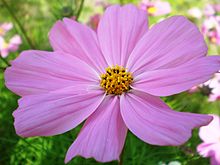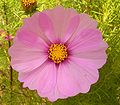- Cosmos bipinnatus
-
Cosmos bipinnatus Scientific classification Kingdom: Plantae (unranked): Angiosperms (unranked): Eudicots (unranked): Asterids Order: Asterales Family: Asteraceae Genus: Cosmos Species: C. bipinnatus Binomial name Cosmos bipinnatus
Cav., 1791Cosmos bipinnatus, commonly called the garden cosmos or Mexican aster, is a medium sized flowering herbaceous plant native to Mexico. The species and its varieties and cultivars are popular as an ornamental plant in temperate climate gardens. It can also be found in natural areas in much of North America, where it is a "garden escapee"-introduced species and in some habitats becoming a pest weed.
Contents
Description
Cosmos bipinnatus is considered a half-hardy annual, although plants may re-appear via self-sowing for several years. The plant height varies from two to four feet. The cultivated varieties appear in shades of pink and purple as well as white. Its foliage is finely cut into threadlike segments. When flowering, the plant can become top heavy. This problem is alleviated when grown in groups, as the bi-pinnate leaves interlock, and the colony supports itself.
Varieties
Some of the varieties of Cosmos bipinnatus in cultivation today include:
- Sensation, also known as Early Sensation, is a widely available mix of tall varieties
- Versailles and Sonata, developed for the cut flower trade, are shorter than the species, with heights remaining below three feet
- Daydream features a pink inner ring on a white background
- Seashells features quilled petals
Cultivation
Growth characteristics of this plant include:
- Germination takes between 7 and 10 days at the optimal temperature of 75 degrees Fahrenheit (24 °C); flowering begins between 60 and 90 days after germination
- It prefers a soil pH between 6.0 and 8.5, reflecting its native habitat in the alkaline regions of Central America
- Flowering is best in full sun, although partial shade is tolerated
- The plant is tolerant to drought after germination, and is seldom subject to insect or disease damage.
Pollinators
The flowers of Cosmos bipinnatus attract birds and butterflies, including the Monarch butterfly. It can be part of butterfly gardening and pollinators-honey bee habitat gardens.
Gallery
References
- Cosmos history and cultivation
- Cosmos Festival in Argentina - Press and video
External links
- Jepson Manual Treatment - Cosmos bipinnatus
- USDA Plants Profile
- Cosmos bipinnatus - Photo gallery
Categories:- Cosmos (plant)
- Flora of Mexico
- Garden plants of North America
- Plants and pollinators
- Butterfly food plants
- Honey plants
- Flowers
Wikimedia Foundation. 2010.








